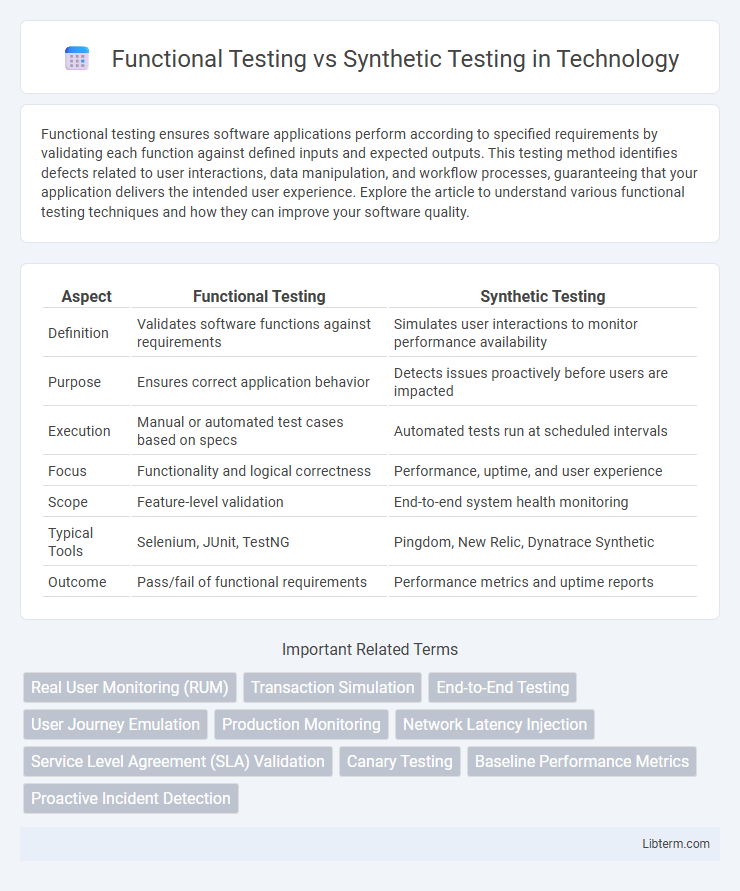Functional testing ensures software applications perform according to specified requirements by validating each function against defined inputs and expected outputs. This testing method identifies defects related to user interactions, data manipulation, and workflow processes, guaranteeing that your application delivers the intended user experience. Explore the article to understand various functional testing techniques and how they can improve your software quality.
Table of Comparison
| Aspect | Functional Testing | Synthetic Testing |
|---|---|---|
| Definition | Validates software functions against requirements | Simulates user interactions to monitor performance availability |
| Purpose | Ensures correct application behavior | Detects issues proactively before users are impacted |
| Execution | Manual or automated test cases based on specs | Automated tests run at scheduled intervals |
| Focus | Functionality and logical correctness | Performance, uptime, and user experience |
| Scope | Feature-level validation | End-to-end system health monitoring |
| Typical Tools | Selenium, JUnit, TestNG | Pingdom, New Relic, Dynatrace Synthetic |
| Outcome | Pass/fail of functional requirements | Performance metrics and uptime reports |
Introduction to Functional Testing vs Synthetic Testing
Functional testing evaluates software applications by verifying that each feature operates according to specified requirements, ensuring correct behavior through real user scenarios and input validation. Synthetic testing simulates user interactions and transactions in a controlled environment to monitor system performance and availability without relying on actual user activity. Both testing methods play crucial roles in enhancing application reliability and user experience by identifying functional issues and preemptively detecting potential performance bottlenecks.
Defining Functional Testing
Functional testing evaluates software features by validating their behavior against specified requirements, ensuring each function operates correctly under various conditions. It involves testing user interactions, APIs, databases, and security to verify the system's practical functionality. This contrasts with synthetic testing, which simulates user activity to monitor system performance and availability proactively.
Defining Synthetic Testing
Synthetic testing involves simulating user interactions or system transactions in a controlled environment to proactively monitor application performance and availability. Unlike functional testing, which verifies specific features against requirements, synthetic testing continuously generates automated tests to detect issues before real users are affected. This method leverages scripted scenarios and performance metrics to ensure consistent user experience and identify potential bottlenecks.
Key Differences Between Functional and Synthetic Testing
Functional testing evaluates software behavior by executing real application scenarios to verify correctness against specified requirements, focusing on user interactions and business logic validation. Synthetic testing involves scheduled, automated scripts simulating user actions from various geographic locations to monitor application performance and availability proactively. The key difference lies in functional testing's emphasis on actual code functionality, whereas synthetic testing prioritizes system uptime and responsiveness through continuous synthetic user activity simulation.
Use Cases for Functional Testing
Functional testing is primarily used to validate that software features operate according to specified requirements, ensuring all user interactions and business processes behave correctly. Common use cases include verifying input validation, form submissions, user authentication, and transaction processing workflows. This testing approach is crucial for regression testing after code changes and confirming integration points in complex applications to maintain functional integrity.
Use Cases for Synthetic Testing
Synthetic Testing is primarily used to simulate user interactions in controlled environments to proactively detect performance issues and outages before they impact real users. It is essential for continuous monitoring of critical business transactions, validating uptime, and ensuring consistent functionality across multiple geographies and devices. Unlike Functional Testing, which validates application features after development, Synthetic Testing continuously generates scripted tests to verify system availability and response times in production.
Advantages of Functional Testing
Functional testing offers a detailed validation of software behavior against real user requirements, ensuring that each feature performs as expected under various conditions. It provides comprehensive defect detection by evaluating actual application responses, leading to higher software quality and reliability. This type of testing supports better risk mitigation by identifying functional issues early in the development cycle, reducing potential failures in production environments.
Advantages of Synthetic Testing
Synthetic testing enables proactive identification of system issues by simulating user interactions consistently regardless of real user traffic, ensuring continuous performance monitoring and early detection of anomalies. It provides comprehensive coverage of critical paths and edge cases that may not be triggered during functional testing, enhancing reliability and robustness of applications. Automated and repeatable nature of synthetic tests significantly reduces downtime risk and supports SLA compliance by maintaining optimal user experience across different environments.
Challenges in Implementation
Functional testing faces challenges in creating comprehensive test cases that cover all user interactions and ensuring compatibility across diverse environments and configurations. Synthetic testing struggles with simulating realistic user behavior, maintaining test scripts amid dynamic application updates, and managing the cost of continuous monitoring infrastructure. Both methods require balancing accuracy, scalability, and maintenance to effectively detect issues without excessive false positives or resource overhead.
Choosing the Right Testing Method for Your Needs
Functional testing evaluates software performance by simulating real user interactions to verify that all features work as intended under actual conditions. Synthetic testing generates scripted, automated tests to proactively monitor system behavior and identify issues before users encounter them, providing consistent and repeatable results. Selecting the right method depends on your goals: use functional testing for thorough validation of user workflows and synthetic testing for continuous performance monitoring and early problem detection.
Functional Testing Infographic

 libterm.com
libterm.com